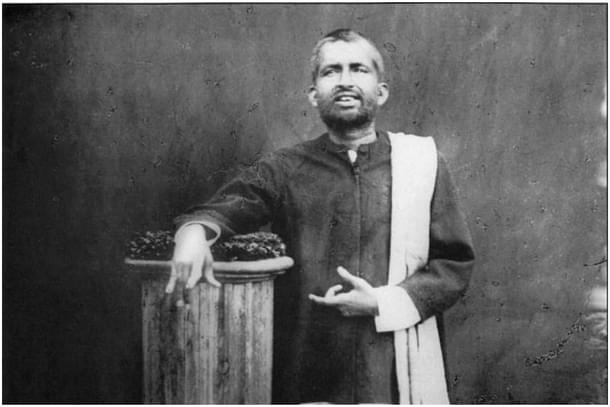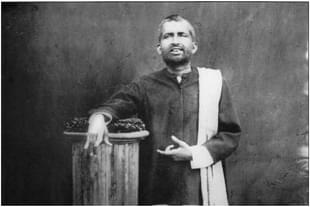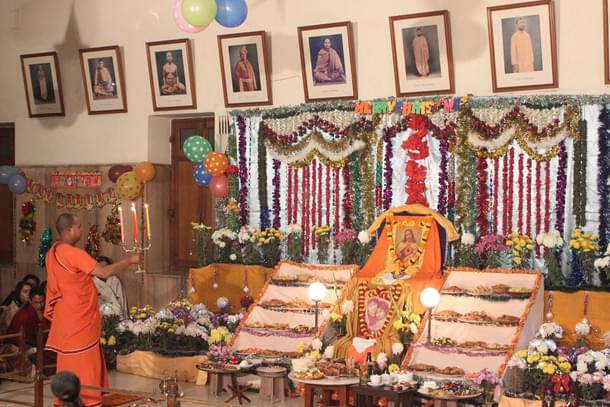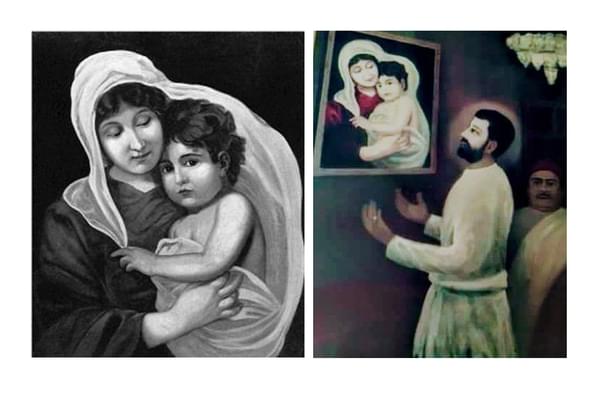Ideas
From Sri Ramakrishna To Sita Ram Goel: A Description Of Hindu Engagement with Christianity
Aravindan Neelakandan
Dec 25, 2021, 03:36 PM | Updated 03:36 PM IST
Save & read from anywhere!
Bookmark stories for easy access on any device or the Swarajya app.


Come Christmas season and Sri Ramakrishna Mission-bashing becomes a ritual. Photos of the Mission celebrating Christmas, available on social media, become the focus of attacks.
Sri Ramakrishna Mission's celebration of Christmas should be understood, and then appreciated or criticized, in the larger context of Hindu engagement with Christianity.

The most influential and defining format for Hindu interaction with Christianity was set in modern times by Sri Ramakrishna, the guru of Swami Vivekananda. He demonstrated that a Hindu can have direct experience of Jesus without having to accept Christianity.
Sri Ramakrishna’s 'Christ experience' came in 1874. His biography published in 1924 has this to say about it:
One day the Master was in the parlour of the garden-house of Jadu Nath Mallik at Dakshineswar, on the walls of which were many beautiful portraits, one of them being Christ’s. Sri Ramakrishna was looking attentively at the picture of the Madonna with the Divine Child and reflecting on the wonderful life of Christ, when he felt as though the picture had become animated, and that rays of light were emanating from the figures of Mary and Christ, and entering into him, altogether changing his mental outlook.
For three days Sri Ramakrishna was held in the grip of his experience of Christian devotion.

He could not bring himself to Hindu Divinities despite his appeal to the Divine Mother (Kali). Then on the fourth day he had an experience:
On the fourth day, as he was walking in the Panchavati, he saw an extraordinary-looking person of serene aspect approaching him with his gaze intently fixed on him. Sri Ramakrishna was charmed and wondered who he might be. Presently the figure drew near, and from the inmost recesses of Sri Ramakrishna’s heart there went up the note, 'There is the Christ who poured out his heart's blood for the redemption of mankind and suffered agonies for its sake. It is none else but that Master-Yogin Jesus, the embodiment of Love!'
Theologian Daniel E. Bassuk in his Incarnation in Hinduism and Christianity points out the significance of this experience of Sri Ramakrishna:
Ramakrishna's mystical experience with Jesus in 1874 is highly significant, as it marks the beginning of the assimilation of Jesus Christ into the Hindu religion on a par with the Hindu Avatars. From this time forward, the Hindu God-men have a spiritual brother in Sri Isha, another Avatar to contend with, and a Western one at that.
After this, in 1882, an American missionary, Joseph Cook of ‘Protestant orthodoxy’ met Sri Ramakrishna in a cruise arranged by Brahmo leader Keshab Chandra Sen. The official organ of Brahmo Samaj, ‘The New Dispensation’ (26-Feb-1882) reported this about the meeting:
The revered Paramahamsa of Dakshineswar [Sri Ramakrishna] ... successively went through all the phases of spiritual excitement which characterizes him. Passing through a long interval of unconsciousness, he prayed, sang, and discoursed on spiritual subject. Mr. Cook represented the extreme culture of Christian theology and thought. The Paramahamsa represented the extreme culture of Indian Yoga and Bhakti, in short the traditional piety of the East. ...
In 1886 Indian Mirror in its obituary of Sri Ramakrishna mentioned that 'Mr.Cook the American evangelist, ...witnessed Ramakrishna's divine exercises and he expressed his great surprise at it and remarked that he was not aware before that a man could become so much immersed in divine spirit as to lose all perception of the external world.'
While Sri Ramakrishna once enquired from Mahendranath Gupta ('M') about Cook and his lectures in Kolkata, Joseph Cook himself never mentioned Sri Ramakrishna. In 1893, he saw in Swami Vivekananda an enemy. Prof. Lola Williamson in her study of ‘Hindu inspired meditation movements’ in the US writes:
One of Vivekananda’s critics was the Reverend Joseph Cook of Boston, who had met Ramakrishna, Vivekananda’s guru, and Keshab Chunder Sen, a leader of the Brahmo Samaj, in India in 1882. ... Cook was unsuccessful in dampening the spirits of those Americans who were eager to hear a new perspective, and after the World Parliament Vivekananda spent many years lecturing to enthusiastic audiences in much the same way that Emerson had done—in fact, reiterating many of the themes about which Emerson had spoken.
Even as the expression of Hindu Bhakti of Sri Ramakrishna, which also included a mystic experience of Christ, had no impact on the evangelist, the impact Christian theology had on Sri Ramakrishna is important. Seven months after Rev. Cook witnessed Sri Ramakrishna, the following conversation of Sri Ramakrishna with Keshab Chandra Sen, was recorded by ‘M’, on 27 October 1882:
Once someone gave me a book of the Christians. I asked him to read it to me. It talked about nothing but sin. (To Keshab) Sin is the only thing one hears of at your Brahmo Samaj, too. The wretch who constantly says, ‘I am bound, I am bound’ only succeeds in being bound. He who says day and night, ‘I am a sinner, I am a sinner’ verily becomes a sinner.
In the room of Sri Ramakrishna along with the pictures of Hindu Gods, Goddess and saints there was also a picture of Jesus ‘raising the drowning Peter’. When Sri Ramakrishna applied vermillion brought by a devotee to the pictures of Hindu Gods and Goddesses, he left out that of Jesus. So, he clearly respected the cultural context of Jesus while at the same time holding on to his own experiential conviction of the universal divinity manifesting through Jesus.
One of the songs he often heard from his disciples including Naren (later Swami Vivekananda), had the following lines:
O Mother, make me mad with Thy love!
...
Jesus, Buddha, Moses, Gauranga,
All are drunk with the Wine of Thy love.
O 'Mother, when shall I be blessed
By joining their blissful company.
This situating of Jesus in the company of other spiritual masters and seeing them as filled with the love for the Goddess rather than the masculine transcendental Father, further enriches the space for engagement and dialogue with Christian tradition.
The Gospel of Sri Ramakrishna also records the visit of one Misra – who was born in ‘a Christian family in northwestern India and belonged to the Quaker sect.’ He visited Sri Ramakrishna and in the course of their conversation told that he had a vision of Jesus. Misra said that ‘it is Rama alone who dwells in all beings' and Sri Ramakrishna said looking at 'young Naren' that 'Rama is one but He has a thousand names' and that whom Christians call 'God' and 'is addressed by the Hindus as Rama, Krishna, Isvara, and by other names.'
Misra told the devotees there that Jesus was not son of Mary but God Himself and that Sri Ramakrishna too was God Himself and that he had seen Sri Ramakrishna too in his vision. Later Sri Ramakrishna blessed Misra saying that he would obtain what he sought.
Thus, with Sri Ramakrishna, Hinduism acquired a spiritual framework to understand Christ and his teaching and experience the spiritual possibilities within Christianity, without acquiring the theological and institutional colonialism that comes with proselytizing. Most of the later Hindutva engagements and dialogues with Christianity are anchored on this, with Veer Savarkar and Guru Golwalkar being clear instances and Sitaram Goel being a prominent exception.
Swami Vivekananda had taken missionaries' propaganda head on. He even pointed out the subliminal racial aspects in the missionary propaganda against Hindus and Hinduism. In his reply to the congratulatory meeting held for his success in the United States World Parliament of Religions he wrote to his fellow countrymen this:
It is not true that I am against any religion. It is equally untrue that I am hostile to the Christian missionaries in India. But I protest against certain of their methods of raising money in America. What is meant by those pictures in the school-books for children where the Hindu mother is painted as throwing her children to the crocodiles in the Ganga? The mother is black, but the baby is painted white, to arouse more sympathy, and get more money. What is meant by those pictures which paint a man burning his wife at a stake with his own hands, so that she may become a ghost and torment the husband's enemy? ... What have the Hindus done to these disciples of Christ that every Christian child is taught to call the Hindus "vile", and "wretches", and the most horrible devils on earth?
This perhaps is the first Hindu observation of the anti-Hindu propaganda material published in the United States by the Christian missionaries.
Later, Sri Aurobindo in a letter to Dilip Kumar Roy observed:
… though Christ and Krishna are the same, they are the same in difference, that is indeed the utility of so many manifestations instead of there being only one as these missionaries would have it. But is it really because the historical Christ has been made too much the foundation-stone of the faith that Christianity is failing? It may be something inadequate in the religion itself – perhaps in religion itself; for all religions are a little off-colour now. ... I don’t know why so many Christian writers have a way of writing and preaching which gives a sense of unpleasant unctuousness, a very small dish of religious emotion swimming in a too fat oil of holiness – as if the Pharisees and Sadducees had not only crucified Christ but laid the grip of their ecclesiasticism and Pharisaism on the religion also.
In modern times, Mahatma Gandhi made a definite contribution to the contours of later Hindutva's interaction with Christianity.
In 1926, answering an American Christian leader Milton Newberry Frantz, who had sent him an article on Jesus positioning him as god, Gandhi wrote back:
I am afraid it is not possible for me to subscribe to the creed you have sent me. The subscriber is made to believe that the highest manifestation of the unseen reality was Jesus Christ. In spite of all my efforts, I have not been able to feel the truth of that statement. I have not been able to move beyond the belief that Jesus was one of the great teachers of mankind.
Then in 1935, when he was talking to a group of missionaries, he told them bluntly:
If I had power and could legislate, I should certainly stop all proselytizing. It is the cause of much avoidable conflict between classes and unnecessary heart-burning among missionaries. But I should welcome people of any nationality if they came to serve here for the sake of service. In Hindu households the advent of a missionary has meant the disruption of the family coming in the wake of change of dress, manners, language, food and drink.
Hindus per se do not have any criticism of Christianity as a false religion or have a compulsion to reject Jesus as a 'false' god or messiah. However, two centuries of attacks on Hindus directly and indirectly through academia and polemics through institutional means and through cultural wars have made many Hindu ideologues study Christianity, if only to defend themselves.
Writes Sita Ram Goel, in the preface to his work on Hindu-Christian encounters said:
No Hindu thinker has had the least objection to Christians believing in and seeking salvation through Jesus. Nor do Hindus bother about the dogmas of the only son-ship, the virgin birth, the atoning death, the resurrection and the rest, so long as Christians keep these to themselves. It is only when the Christian missionary apparatus tries doggedly to impose these dogmas on other people that Hindu thinkers are forced to register a protest and have a close look at the Jesus of history.
While Hindu influence on Christianity has been positive with respect to inculcating it with Yoga and diverse spirituality, the Christian-Hindu encounter in India has been that of a battle-field. Christianity—from the Catholic Church to evangelists of Protestantism—wants to conquer Hinduism and sees it as a potential field of harvest for the current millennia.
The Hindu response in terms of religion and theology can be divided into two broad categories.
One is represented by Sita Ram Goel – characterizing Jesus as ‘an artifice of aggression.’ In his book, Sita Ram Goel starts with his own experience:
Jesus did say in so many words not only that he was the only God but also that those who did not accept his claim would burn forever in the infernal pit. I realized with painful surprise that Jesus was not all Sermon on the Mount as I had been led to believe by his Hindu votaries. Years passed, and I had no time to spare for Jesus. I turned to him again in the eighties when Ram Swarup made me wise about the character of monotheistic creeds. It was then that I turned to the gospels. I was horrified. Now I could see why the history of Christianity had been what it had been. The source of the poison was in the Jesus of the gospels.
He concludes in the book:
It is high time for Hindus to learn that Jesus Christ symbolises no spiritual power, or moral uprightness. He is no more than an artifice for legitimizing wanton imperialist aggression. The aggressors have found him to be highly profitable so far. By the same token, Hindus should know that Jesus means nothing but mischief for their country and culture. The West where he flourished for long, has discarded him as junk. There is no reason why Hindus should buy him. He is the type of junk that cannot be re-cycled. He can only poison the environment.
The other dominant Hindu attitude to Christianity is characterized by the highly popular lecture, ‘Christ we Adore’, of Swami Ranganathananda of Sri Ramakrishna Mission. He gives a complete Vedantic gloss over the life and teachings of Jesus. Here is a typical sample passage from ‘Christ We Adore’:
The ‘Sermon on the Mount’ expounds moral and spiritual ideas which are universal; ... and will not sound strange to any spiritual seeker nourished on the ideas of the Upanishads and the Bhagavad-Gita. ... ‘Be ye therefore perfect, even as your Father which is in heaven is perfect.’ This exhortation sounds strangely Vedantic in significance. ... Here is a refreshing statement of the scope and goal of religion. The emphasis is on sadhana, the practice of religion, with a view to attaining anubhava, realization. ‘Religion is realization; it is being and becoming’, in the words of Swami Vivekananda; it is character. It is not a cosy belief, but an adventure, something that sets the soul on fire, the carrying, as Jesus would say, of one’s cross by oneself and not by proxy.
Most of the Hindu responses to Christian core belief system varies between these two approaches. And that provides quite a lot of middle ground.
Ram Swarup, the Guru and mentor of Sita Ram Goel, considered the Bible as the source that raised English language morally and spiritually.
Elsewhere Ram Swarup elaborates:
By the time of Jesus, ... the Jewish world ... was open to all kinds of influences both from the East as well as the West. … Jesus belonged to this environment. … But he was one of those who must experience spiritual truths in their person. He was invaded by a sense of holy presence that he simply called his Father. In the Gospel part of the New Testament, there is no controversy about one God and many Gods, between Theism and Polytheism, between True God and False Gods. Jesus had no relish for intellectual, theological controversies. His simple message to the Jews is to love their God with all their heart and to do unto others what they would like others to do unto themselves. The attempt was to bring a measure of inwardness to their worship. But as we proceed from the Gospels to the Acts, we find a spiritual deterioration. There is less direct experience and more of faith, less simplicity and more rhetoric … With introduction and triumph of Pauline Christianity, a new element came into religious culture, a passionate narrowness, a fanatic faith, a doctrinaire intellectuality, a sanctimonious piety.
This is more in tune with Gandhian approach. While accepting that Jesus did have spiritual passion, there is rejection of the exclusivist theology of Christianity and its evangelical actions derived from that theology.
Swami Ranganathananda also makes a detailed exposition of this problem even as he presents a Vedantic gloss over the life and teachings of Nazarene. In the end of his ‘Christ We Adore’, Swami Ranganathananda states:
The dogma of one man’s sin affecting all humanity gave rise to its logical corollary of the dogma of one man’s blood washing away the sins of all; such an approach led inevitably to a chain reaction of such tragedies involving the lives of Stephen and Joseph, Peter and Paul, immediately after, and of countless other good and noble and innocent souls, thereafter. ... in place of calm reason and generous love, frenzy, fanaticism, intolerance, and bigotry gripped the propagation of the life-giving message of Jesus down the centuries, destroying as many lives as it undoubtedly helped to build, with, groups interchanging places as persecutor and victim. ...
The history of Christianity, in its twin records of persecution, violence, and war, on the one side, and lofty mysticism, moral passion, and humanitarianism on the other, bears the impress of this inner division, which also explains its recurrent conflicts with science. ... It is against this background that we view with hope the future of Indian Christianity. Under the guidance of the philosophy of Vedanta, the Christian message in India can achieve that synthesis by which it will flow as an entirely constructive force with its universal elements functioning free in the spirit of the universal, and its dogmatic elements digested and retained to accord with the spirit of the universal and human....
One can see how in a deeper process of samanvaya, the voice of Ram Swarup and Swami Ranganathananda unite. It is an on-going process and there are no defined boundaries. When we deal in set-categories we can easily become the dragon we fight. Hindutva as a nation-building process is far more complex, organic and assimilating than we like to imagine with the instant gratification provided by social media and hatred.
Aravindan is a contributing editor at Swarajya.





